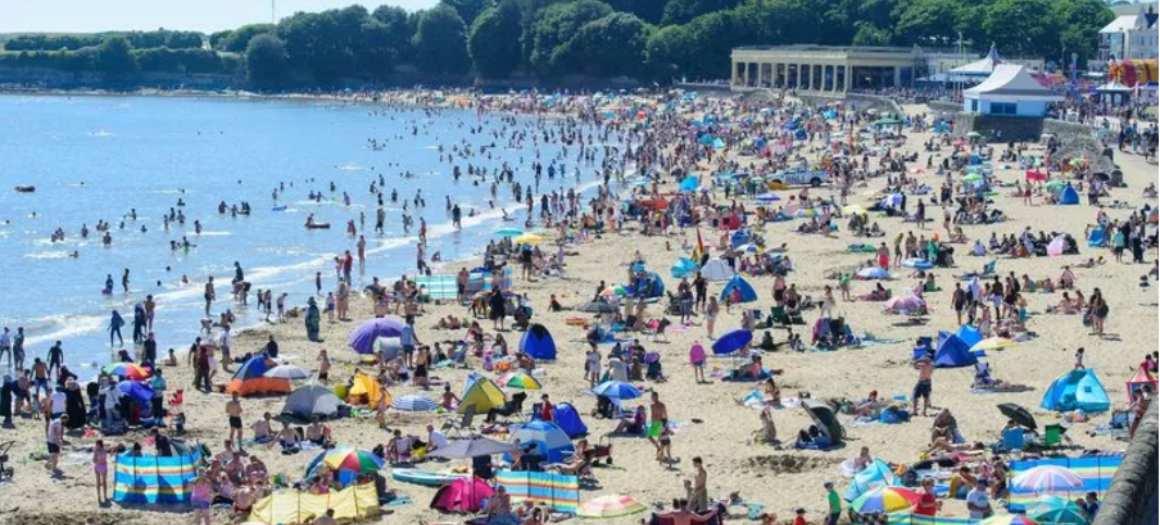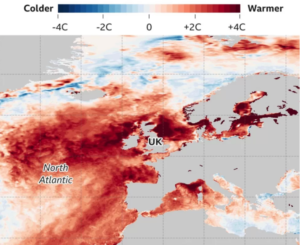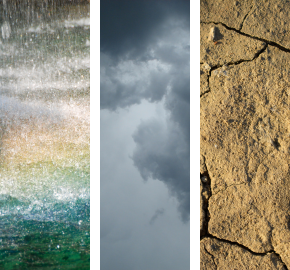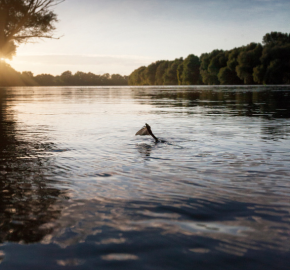Rising sea temperatures around the UK and the potential threat to wild fish

Millions across the UK have been enjoying a sweltering start to the summer, but unusually high temperatures at sea could spell trouble for marine and freshwater wildlife. The Met Office confirmed that global sea surface temperatures for April and May smashed previous records, at their highest since monitoring began in 1850.
An ‘unprecedented’ marine heatwave in UK waters
The US National Oceanic and Atmospheric Administration has classified the abnormally high sea temperatures in UK waters as a ‘category 4’ heatwave. Cat 4 marine heatwaves are described as ‘extreme’ and are rarely observed outside the tropics. Now scientists are concerned about the current conditions in the North Atlantic which may impact wild fish populations in the UK. Off the northeast coast of England and the west of Ireland, sea temperatures are as much as 5 degrees warmer than average over the past 30 years.
Warmer seas are also linked to more extreme storms, amplified by the increased thermal energy which may lead to flash floods across the UK and potentially sewage overflows into our lakes and rivers.

SST anomalies in the North Atlantic 20/06/23. Credit: Met Office, European Space Agency, BBC.
What is causing the North Atlantic to warm?
Sea temperatures are intrinsically linked to global oceanic and atmospheric circulation so it is difficult to point to one single underlying cause for the current heat wave. Over the past decade, the North Atlantic has been on average cooler than would be expected, so the current high temperatures have come as a surprise to many scientists. Possible factors at play include:
1. Trade winds
The south-westerly winds which are most common in the UK are unusually weak at the moment which means less dust from the Sahara Desert is being transported to Northern Europe. Saharan dust reflects sunlight back into space reducing the rate at which the oceans warm.
2. Variations in ocean and atmospheric circulation
Natural variations in ocean and atmospheric circulation such as Gulf Stream may also be playing a role in warmer ocean temperatures.
Warming sea temperatures could spell disaster for wild fish
Heatwaves at sea, much like on land result in stresses to wildlife not adapted to such extreme temperatures. The Marine Biological Association has been assessing the current threat to marine wildlife posed by the heatwave. Dr Dan Smale said: “current temperatures are way too high but not yet lethal for the majority of species, although stressful for many… If it carries on through summer we could see mass mortality of kelp, seagrass, fish and oysters”.
Mass fish deaths are already happening elsewhere in the world due to rising sea temperatures. Earlier this month thousands of dead fish, mostly Gulf Menhaden, washed up along Texas beaches. Higher temperatures reduce the dissolved oxygen available in the water, essentially suffocating the fish leading to mass mortality events known as ‘fish kills’.
UK fish could starve if high temperatures continue
Plankton, a keystone species of plant in the marine ecosystem which form the basis of the marine food chain, rely on nutrients from colder, more productive waters deeper in the ocean. Higher sea surface temperatures mean that the ocean becomes more strongly stratified (the separation of water due to density) and the colder nutrient rich deep water does not mix with the warmer surface water.
Many native fish species naturally synchronise their reproductive cycles with annual plankton blooms and anomalous weather events such as marine heatwaves risk disrupting this relationship. If ocean warming continues, we may see many fish species native to UK waters being replaced by other species better adapted to warmer temperatures.
Global warming is making our climate more difficult to predict, with extreme events such as marine heatwaves becoming more commonplace. Whilst the current high sea surface temperatures can be viewed as a rare anomaly, it is also an early sign of things to come and how fragile the UK’s aquatic ecosystem is in the face of climate change.
Rising sea temperatures and the risk posed by sea lice
Seawater temperature has a major impact on the survival, reproduction rate and even infection success of sea lice (Lepeophtheirus salmonis). As seawater temperatures increase, sea lice can grow more rapidly, produce eggs more frequently and infect fish more readily.[1] In practice, this means that the number of sea lice emanating from open-net salmon farms can increase substantially as water temperatures increase. In fact, the number of days it takes sea lice eggs to hatch decreases substantially with increasing temperature; at 12°C, sea lice eggs only take 6.7 days to hatch, 2.7 times faster than at 6°C (16.8 days). Consequently, as temperatures rise, so to do the number of sea lice emanating from a single farm. Warmer temperatures can therefore increase the risk of potentially fatal infections in wild salmon and sea trout smolts.
If this wasn’t concern enough, at higher seawater temperatures, sea lice have better success attaching to, and infecting, salmon; one study found that fish infected at 10°C harboured twice as many copepodites as fish infected at 3°C.[2] This may prove fatal to our already struggling wild salmon and sea trout smolts.
As our seas warm, the duration and impact of sea lice is ever increasing. Warmer waters during winter months now provide little relief to the farmed fish from the burden of sea lice. In the summer months, the sea lice infestations can be much more severe and result in larger blooms of sea lice emanating from farms. The risk to our wild salmon and sea trout has never been greater.
List of references:
[1] https://bora.uib.no/bora-xmlui/bitstream/handle/1956/20967/q011p429.pdf?sequence=3&isAllowed=y
[2] https://onlinelibrary.wiley.com/doi/10.1111/jfd.13253




